
This Mordant Monday, I want to share a little bit about my pokeberry dye adventure this past week. Those of you who know me know that I was trained to mordant nearly everything (exception: indigo). Not mordanting something that needs a mordant usually elicits a shocked, silent, but oh-so-judgey raised eyebrow, so this post is a stretch for me. The interesting thing about pokeberries is that it’s possible to get a brilliant color by using wool yarn and white vinegar. No alum mordant is used in this technique. And vinegar is not normally considered a mordant. So here we are.
Pokeberry (Phytolacca americana) is a North America native plant that creates a vivid magenta shade on wool yarn. It is not a robust color and is considered fugitive, and will quickly fade and shift when exposed to light. It has been used for ink, and possibly for dyeing fibers, but I have never seen a pokeberry dyed garment that retained its color.
I first became aware of pokeberries from Rebecca Burgess’ book Harvesting Color. I was thrilled to see them when I was visiting John Marshall in Mendocino. His front yard was filled with pokeberry bushes, and he graciously let me fill a huge bagful of the juicy, purple black berries. I flew them home to Seattle and stared at them a few days as I prepared some wool yarns and fabrics. When the fruit flies became too numerous to ignore any longer, I followed the recipe in the book. Rebecca’s recipe is from Carol Leigh Brack-Kaiser of Hillcreek Fiber Studio, and I’ve always had success with it.
The first thing people ask about pokeberries is: aren’t they fugitive? Fugitive meaning that the color disappears or fades quickly. Pokeberry dye is fugitive, but I have skeins of pokeberry dyed wool from 2011 and they are still a good strong red. After 14 years, I can see that the color is fading and shifting a bit, but I think that’s a pretty good result. I have not worn pokeberry dyed fibers or put them through multiple washes, so that can be an experiment you can try.
Mature pokeberry plants and fruit are toxic, so they should not be eaten, and you may want to use gloves when working with the berries.
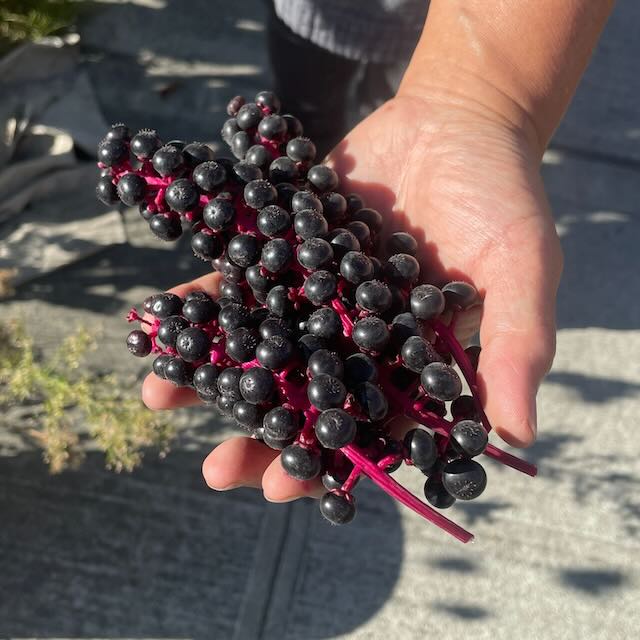
Here’s how we did it.
Gather pokeberries. You need a lot to get brilliant colors.
Soak clean wool yarn in a white vinegar and water solution. I used about a cup of vinegar to a 3-gallon plastic bucket of water and soaked the skeins overnight in the room temperature solution.
Remove the berries from their stems and crush the berries in a dye pot. We did not heat the pokeberry solution (I forgot), and combined the crushed berries with room temperature water and another cup of vinegar. Fill the dye pot with enough water so the yarn can move easily in the pokeberry dye. Some dyers like to strain the pokeberry seeds and skins. We did not do this.
Immerse the vinegar soaked wool skeins in the pokeberry dye bath and let them soak at room temperature overnight. Some dyers will heat the pokeberry bath and also get good results, but these skeins stayed at room temperature, and we’ve found that we get much better color if we don’t heat the dye bath.
When the yarn is the color that you like, remove from the pokeberry bath, let drip and dry away from direct sunlight. After they are bone dry, carefully shake out the seeds and debris and carefully rinse. Hang for final dry away from direct sunlight.
Pokeberry observations:
1. The rich purple-black color of pokeberry comes from a type of anthocyanin, which is the same type of color found in red beets and amaranth, and it also behaves in a similar manner. That means that it turns very reddish purple with acids and grayish purple with bases (alkali), and that it is not particularly wash or lightfast, so I dye with it with an experimental mindset. It is not going to be a color that I use for artwork, heirloom or production projects.
2. The mature plant is poisonous if ingested, and so are the berries. Some people react to the juice with a skin rash. We recommend you work in a well-ventilated area and wear gloves when dyeing and keep this dye plant away from small children and pets.
3. The color seems to work with animal fibers (wool, silk, alpaca and mohair) and I’ve had the best results with wool. Silk will dye a lighter color than wool. Pokeberry does not work well on cotton, hemp, linen or other plant fibers but some dyers have had success with it. If you are curious, give it a try.
4. The color seems to work best if you soak the wool in a vinegar solution, then make a dye bath using more vinegar. This recipe originates from Carol Leigh Brack-Kaiser and her version is also included in Rebecca Burgess’ book, Harvesting Color.
5. You need to use a lot of pokeberry. Rebecca Burgess recommends a 25:1 ratio. This means for 1 pound of wool fiber, you’d collect 25 pounds of berries, but she reassures you that they are heavy and collecting goes quickly.
6. Colors such as tan, orange or gray from pokeberries seem to indicate that the dye bath was not acidic enough, or that the skeins were exposed to bright light. I followed Carol Leigh’s recipe and got some very nice results.
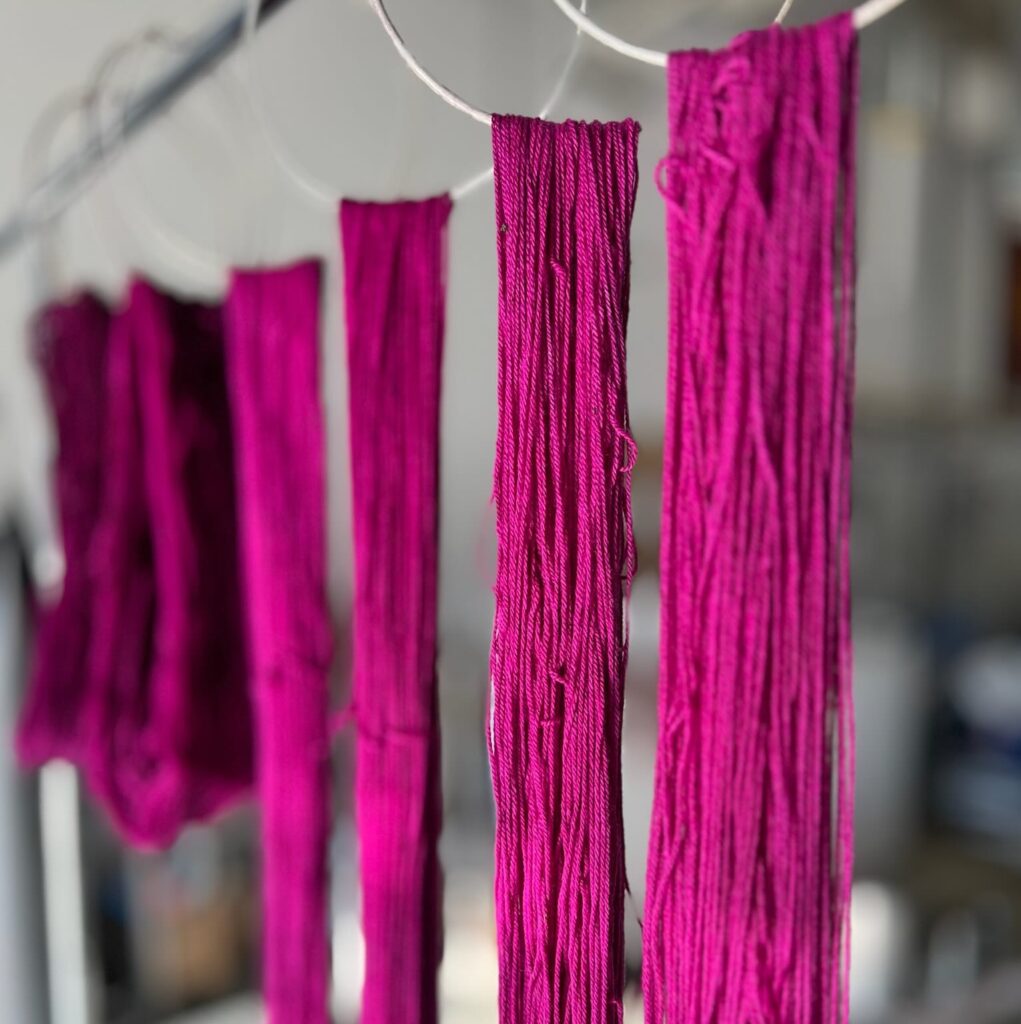


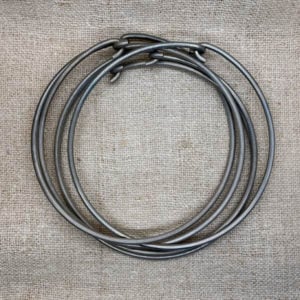
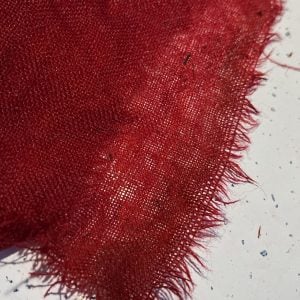

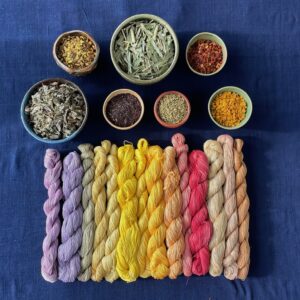

I just discovered the no-heat method for pokeberries and was thrilled, as if you let it boil it turns an uninteresting light brown. I got a stunning orange with it on merino fibre a few weeks ago when I heated it too much but didn’t boil.
Pokeweed is very hard to find in southern Ontario, so if you are harvesting before all the berries on the stem are ripe, strip the ripe ones off and put in water. They ripen quickly, so check daily and take them off as they ripen. Pokeberries freeze well.
The other important thing about pokeberry dye is to let your items dry before rinsing, the dye oxidizes.
I just harvested my pokeweed a couple of weeks ago here in the Sacramento California area. What I’m mainly after is the thin skin for papermaking, but when I harvest I always cut the berries first so they don’t make such a mess when I cut down the rest. I always tell myself ‘just throw them in the compost bin’ and then I just. can’t. do it.
Also following the recipe in Harvesting Color, I’ve had good luck creating a rich magenta dye and have experienced that pinkish color on silk. I typically heated the dye bath – gently. I have a lovely light-weight wool scarf I plan to dye this year, though and I’m definitely going to use the ‘room temp overnight’ method now. Thank you!
P.S. I have LOT of pokeweed because I don’t police it too much. Its beautiful, and the thin skin/bark does make a beautiful handmade paper!
I have had great success with cold bath fresh pokeberry dyeing on wool this year, even starting with only three times WOF ! And the bath keeps going!!! Sometimes I have been adding vinegar to the both the pre soak and dye bath when adding additional fabric/yarn….SOOO amazing! I have a few gallons of Poke berries from last year in the freezer. Will give that a go eventually….Also I am thinking to try painting with a soda ash paste and dipping in an indigo vat to explore the pH magic! Wish I could post photos here…. 2 yards wool jersey, 2 yards wool gauze, bits of boiled wool, felt, handspun yarn and the silk held the berries.
I have used Carol’s recipe several times, as pokeberry is an invasive in California and friends have been happy to have me take them away. I have gotten good results that fade gradually, so use it to dye wool yarn for something that won’t be washed, or see much sunlight. A winter hat, a pouch for storage, maybe even slippers are good examples.